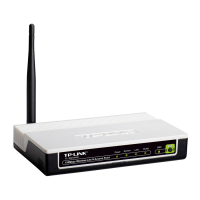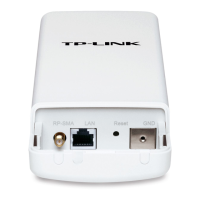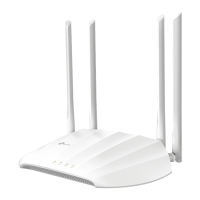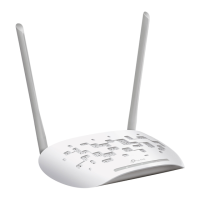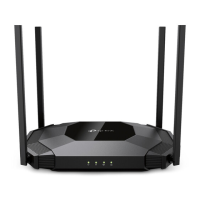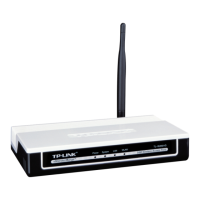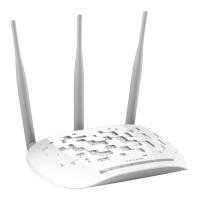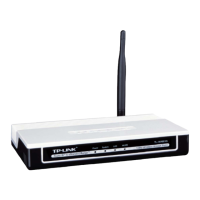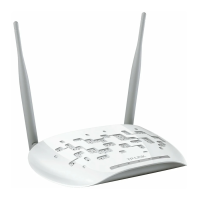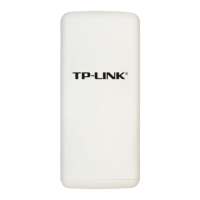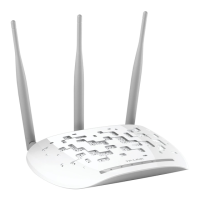Do you have a question about the TP-Link TL-WA7210N and is the answer not in the manual?
Describes the TL-WA7210N's purpose and capabilities for outdoor wireless networking.
Details the key features, standards compliance, and performance specifications.
Explains symbols, terms, and formatting conventions used in the manual.
Illustrates and describes the physical ports, buttons, and indicators on the device.
Details the LED indicators on the front panel of the TL-WA7210N.
Details the ports and reset button on the rear panel of the TL-WA7210N.
Lists hardware and software prerequisites for setting up the device.
Specifies recommended operating temperature and humidity for the device.
Provides step-by-step instructions for physically connecting the device.
Details hardware installation for the AP Client Router operation mode.
Details hardware installation for the AP Router operation mode.
Details hardware installation for the Access Point operation mode.
Details hardware installation for the Multi-SSID operation mode.
Details hardware installation for the Repeater operation modes.
Details hardware installation for the Bridge with AP operation mode.
Details hardware installation for the Client operation mode.
Guides on setting up PC IP addresses to communicate with the AP.
Provides a step-by-step process for quick initial configuration of the AP.
Details the Quick Setup process for the AP Client Router mode.
Details the Quick Setup process for the AP Router mode.
Details the Quick Setup process for the Access Point mode.
Details the Quick Setup process for the Multi-SSID mode.
Details the Quick Setup process for the Repeater mode.
Details the Quick Setup process for the Bridge with AP mode.
Details the Quick Setup process for the Client mode.
Describes the process of logging into the AP's management interface.
Explains how to view the AP's current status and configuration.
Refers to the Quick Setup section for initial configuration.
Explains how to select and configure the AP's operational mode.
Describes the Wi-Fi Protected Setup (WPS) feature for adding devices.
Allows customization of local network settings like IP and subnet.
Configures the IP parameters for the Local Area Network (LAN) port.
Provides options for creating and managing the wireless network.
Configures basic wireless network parameters like SSID and region.
Sets up security measures for the wireless network.
Filters wireless access based on MAC addresses.
Configures advanced wireless parameters for optimization.
Helps in aligning antennas for optimal signal strength.
Adjusts wireless range by optimizing ACK timeout for outdoor links.
Monitors and displays wireless throughput information.
Displays statistics for connected wireless stations.
Manages IP address assignment for devices on the network.
Configures the AP as a DHCP server to assign IP addresses.
Displays a list of devices currently connected via DHCP.
Reserves specific IP addresses for devices based on MAC addresses.
Provides tools for managing device firmware, settings, and logs.
Configures Simple Network Management Protocol for remote monitoring.
Sets the device's time and date for accurate logging and functions.
Performs network diagnostics like Ping and Traceroute.
Monitors network connection and reboots if issues occur.
Tests the network connection speed to and from devices.
Updates the device's firmware to the latest version.
Restores the device's configuration to factory default settings.
Saves and loads device configuration files.
Restarts the device to apply changes or troubleshoot.
Changes the device's administrator username and password.
Views system logs for troubleshooting and monitoring.
Displays network traffic statistics for connected devices.
Describes the process of logging into the AP's management interface.
Explains how to view the AP's current status and configuration.
Refers to the Quick Setup section for initial configuration.
Explains how to select and configure the AP's operational mode.
Describes the Wi-Fi Protected Setup (WPS) feature for adding devices.
Allows customization of local network settings like IP and subnet.
Configures WAN connection types such as Dynamic IP, Static IP, PPPoE.
Clones the MAC address for ISP registration requirements.
Configures the IP parameters for the Local Area Network (LAN) port.
Provides options for creating and managing the wireless network.
Configures basic wireless network parameters like SSID and region.
Sets up security measures for the wireless network.
Filters wireless access based on MAC addresses.
Configures advanced wireless parameters for optimization.
Helps in aligning antennas for optimal signal strength.
Adjusts wireless range by optimizing ACK timeout for outdoor links.
Monitors and displays wireless throughput information.
Displays statistics for connected wireless stations.
Manages IP address assignment for devices on the network.
Configures the AP as a DHCP server to assign IP addresses.
Displays a list of devices currently connected via DHCP.
Reserves specific IP addresses for devices based on MAC addresses.
Manages network traffic through port forwarding and DMZ.
Sets up virtual servers to allow external access to internal services.
Configures port triggering for applications requiring multiple connections.
Configures a DMZ host to expose a local PC to the Internet.
Enables Universal Plug and Play for automatic device discovery.
Configures security settings for the device and network.
Configures basic security features like firewall and VPN passthrough.
Configures advanced security against DoS attacks.
Manages which PCs on the LAN can access the device's settings.
Configures remote access to the device via the Internet.
Controls Internet access for children based on websites and time.
Manages and restricts Internet access for hosts on the LAN.
Sets up rules for Internet access control based on host, target, and schedule.
Manages lists of hosts (PCs) for access control rules.
Manages lists of targets (websites, domains) for access control.
Manages time schedules for Internet access control rules.
Configures static routes and system routing tables for network traffic.
Adds or deletes static routes for specific network paths.
Displays the current system routing table.
Controls and limits bandwidth usage for upload and download.
Configures egress and ingress bandwidth limits.
Manages bandwidth control rules for specific entries.
Binds IP addresses to MAC addresses for enhanced network security.
Sets up IP and MAC address binding entries.
Displays the ARP list showing MAC and IP address relationships.
Configures Dynamic Domain Name System for remote access.
Provides tools for managing device firmware, settings, and logs.
Sets the device's time and date for accurate logging and functions.
Performs network diagnostics like Ping and Traceroute.
Updates the device's firmware to the latest version.
Restores the device's configuration to factory default settings.
Saves and loads device configuration files.
Restarts the device to apply changes or troubleshoot.
Changes the device's administrator username and password.
Views system logs for troubleshooting and monitoring.
Displays network traffic statistics for connected devices.
Describes the TL-WA7210N's purpose and capabilities for outdoor wireless networking.
Details the key features, standards compliance, and performance specifications.
Explains symbols, terms, and formatting conventions used in the manual.
Illustrates and describes the physical ports, buttons, and indicators on the device.
Details the LED indicators on the front panel of the TL-WA7210N.
Details the ports and reset button on the rear panel of the TL-WA7210N.
Lists hardware and software prerequisites for setting up the device.
Specifies recommended operating temperature and humidity for the device.
Provides step-by-step instructions for physically connecting the device.
Details hardware installation for the AP Client Router operation mode.
Details hardware installation for the AP Router operation mode.
Details hardware installation for the Access Point operation mode.
Details hardware installation for the Multi-SSID operation mode.
Details hardware installation for the Repeater operation modes.
Details hardware installation for the Bridge with AP operation mode.
Details hardware installation for the Client operation mode.
Guides on setting up PC IP addresses to communicate with the AP.
Provides a step-by-step process for quick initial configuration of the AP.
Details the Quick Setup process for the AP Client Router mode.
Details the Quick Setup process for the AP Router mode.
Details the Quick Setup process for the Access Point mode.
Details the Quick Setup process for the Multi-SSID mode.
Details the Quick Setup process for the Repeater mode.
Details the Quick Setup process for the Bridge with AP mode.
Details the Quick Setup process for the Client mode.
Describes the process of logging into the AP's management interface.
Explains how to view the AP's current status and configuration.
Refers to the Quick Setup section for initial configuration.
Explains how to select and configure the AP's operational mode.
Describes the Wi-Fi Protected Setup (WPS) feature for adding devices.
Allows customization of local network settings like IP and subnet.
Configures the IP parameters for the Local Area Network (LAN) port.
Provides options for creating and managing the wireless network.
Configures basic wireless network parameters like SSID and region.
Sets up security measures for the wireless network.
Filters wireless access based on MAC addresses.
Configures advanced wireless parameters for optimization.
Helps in aligning antennas for optimal signal strength.
Adjusts wireless range by optimizing ACK timeout for outdoor links.
Monitors and displays wireless throughput information.
Displays statistics for connected wireless stations.
Manages IP address assignment for devices on the network.
Configures the AP as a DHCP server to assign IP addresses.
Displays a list of devices currently connected via DHCP.
Reserves specific IP addresses for devices based on MAC addresses.
Provides tools for managing device firmware, settings, and logs.
Configures Simple Network Management Protocol for remote monitoring.
Sets the device's time and date for accurate logging and functions.
Performs network diagnostics like Ping and Traceroute.
Monitors network connection and reboots if issues occur.
Tests the network connection speed to and from devices.
Updates the device's firmware to the latest version.
Restores the device's configuration to factory default settings.
Saves and loads device configuration files.
Restarts the device to apply changes or troubleshoot.
Changes the device's administrator username and password.
Views system logs for troubleshooting and monitoring.
Displays network traffic statistics for connected devices.
Describes the process of logging into the AP's management interface.
Explains how to view the AP's current status and configuration.
Refers to the Quick Setup section for initial configuration.
Explains how to select and configure the AP's operational mode.
Describes the Wi-Fi Protected Setup (WPS) feature for adding devices.
Allows customization of local network settings like IP and subnet.
Configures WAN connection types such as Dynamic IP, Static IP, PPPoE.
Clones the MAC address for ISP registration requirements.
Configures the IP parameters for the Local Area Network (LAN) port.
Provides options for creating and managing the wireless network.
Configures basic wireless network parameters like SSID and region.
Sets up security measures for the wireless network.
Filters wireless access based on MAC addresses.
Configures advanced wireless parameters for optimization.
Helps in aligning antennas for optimal signal strength.
Adjusts wireless range by optimizing ACK timeout for outdoor links.
Monitors and displays wireless throughput information.
Displays statistics for connected wireless stations.
Manages IP address assignment for devices on the network.
Configures the AP as a DHCP server to assign IP addresses.
Displays a list of devices currently connected via DHCP.
Reserves specific IP addresses for devices based on MAC addresses.
Manages network traffic through port forwarding and DMZ.
Sets up virtual servers to allow external access to internal services.
Configures port triggering for applications requiring multiple connections.
Configures a DMZ host to expose a local PC to the Internet.
Enables Universal Plug and Play for automatic device discovery.
Configures security settings for the device and network.
Configures basic security features like firewall and VPN passthrough.
Configures advanced security against DoS attacks.
Manages which PCs on the LAN can access the device's settings.
Configures remote access to the device via the Internet.
Controls Internet access for children based on websites and time.
Manages and restricts Internet access for hosts on the LAN.
Sets up rules for Internet access control based on host, target, and schedule.
Manages lists of hosts (PCs) for access control rules.
Manages lists of targets (websites, domains) for access control.
Manages time schedules for Internet access control rules.
Configures static routes and system routing tables for network traffic.
Adds or deletes static routes for specific network paths.
Displays the current system routing table.
Controls and limits bandwidth usage for upload and download.
Configures egress and ingress bandwidth limits.
Manages bandwidth control rules for specific entries.
Binds IP addresses to MAC addresses for enhanced network security.
Sets up IP and MAC address binding entries.
Displays the ARP list showing MAC and IP address relationships.
Configures Dynamic Domain Name System for remote access.
Provides tools for managing device firmware, settings, and logs.
Sets the device's time and date for accurate logging and functions.
Performs network diagnostics like Ping and Traceroute.
Updates the device's firmware to the latest version.
Restores the device's configuration to factory default settings.
Saves and loads device configuration files.
Restarts the device to apply changes or troubleshoot.
Changes the device's administrator username and password.
Views system logs for troubleshooting and monitoring.
Displays network traffic statistics for connected devices.
| 2.4 GHz | Yes |
|---|---|
| Modulation | - |
| Frequency band | 2.4 - 2.4835 GHz |
| Number of users | - user(s) |
| Channels quantity | - channels |
| Networking standards | IEEE 802.11b, IEEE 802.11g, IEEE 802.11n, IEEE 802.3, IEEE 802.3ab |
| Receiver sensitivity | 802.11n\\r 150M: -76dBm\\r 121.5M: -78dBm\\r 108M: -80dBm\\r 81M: -84dBm\\r 54M:-87dBm\\r 40.5M:-91dBm\\r 27M:-92dBm\\r 13.5M:-95dBm\\r 802.11g\\r 54M: -79dBm\\r 48M: -81dBm\\r 36M: -85dBm\\r 12M: -92dBm\\r 6M:-95dBm |
| Ethernet LAN data rates | 10, 100 Mbit/s |
| Maximum data transfer rate | 150 Mbit/s |
| Maximum operating distance | 150 m |
| Internal | No |
| Certification | CE, FCC, RoHS |
| WAN connection | Ethernet (RJ-45) |
| Ethernet LAN (RJ-45) ports | 1 |
| Security algorithms | 128-bit WEP, 152-bit WEP, 64-bit WEP, WPA, WPA-PSK, WPA2, WPA2-PSK |
| Storage temperature (T-T) | -40 - 70 °C |
| Operating temperature (T-T) | -30 - 70 °C |
| Storage relative humidity (H-H) | 5 - 95 % |
| Operating relative humidity (H-H) | 10 - 90 % |
| Input current | 1 A |
| AC input voltage | 12 V |
| Compatible operating systems | Microsoft Windows 98SE, NT, 2000, XP, Vista, Windows 7/8, MAC OS, NetWare, UNIX, Linux |
| Antenna gain level (max) | 12 dBi |
| Depth | 120 mm |
|---|---|
| Width | 265 mm |
| Height | 83 mm |
